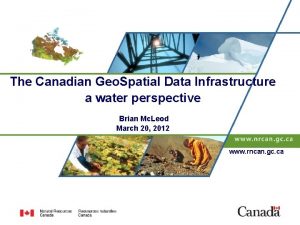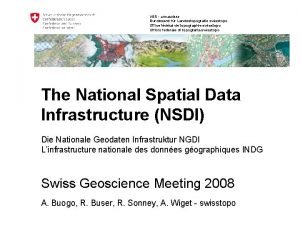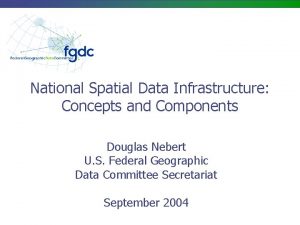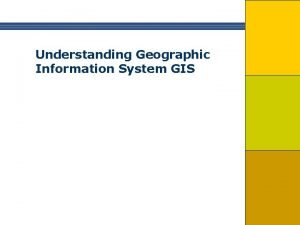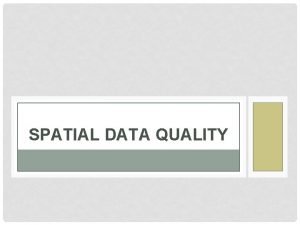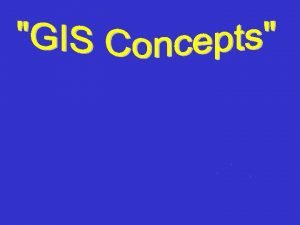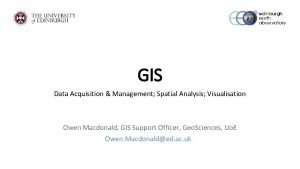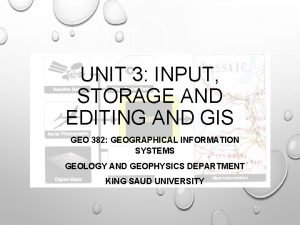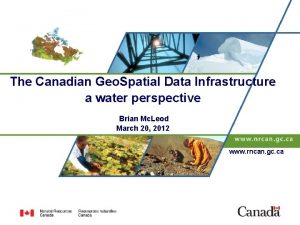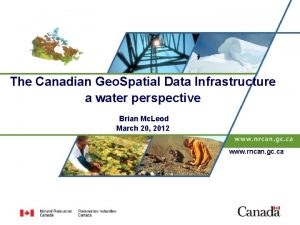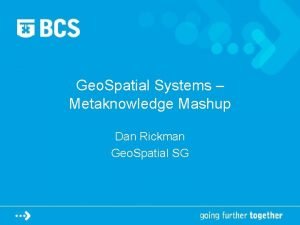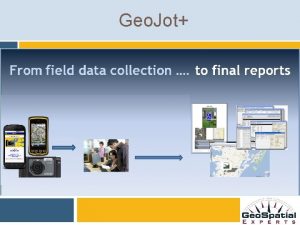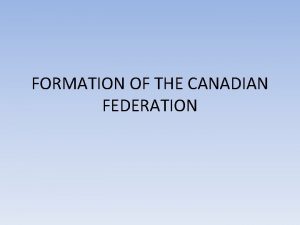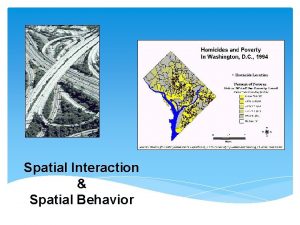The Canadian Geo Spatial Data Infrastructure a water
















- Slides: 16

The Canadian Geo. Spatial Data Infrastructure a water perspective Brian Mc. Leod March 20, 2012 www. rncan. gc. ca

Outline Ø Ø Ø Context Geo. Connections & Canadian Geospatial Data Infrastructure Geo. Connections – a brief history Geo. Connections III – objectives Water perspective – key programs and interoperabilty activities 2

Information and data are global currency… Ø 24/7 digital economy paved the way for even more competition; social and environmental issues more complex, global in nature Ø increasingly technology and sophisticated analytical techniques are increasing the value of data and information Ø open data will underpin new waves of productivity and generate significant financial value and societal benefits Ø creating transparency and making data readily accessible and re-usable will be the hallmark of successful governments …and geospatial information is essential in driving competiveness and facilitating effective decision-making 3 3

Reliable sources of geospatial information are essential to… …support broad national objectives such as economic growth, social cohesion and well-being, and environmental management 4 4

Geo. Connections and has the CGDI Geo. Connections played a key role by building the CGDI… A national program designed to facilitate access to and use of authoritative geospatial information in Canada through the development, integration and use of the Canadian Geospatial Data Infrastructure (CGDI) The CGDI: Ø is the convergence of partnerships, policies, standards, technologies, and framework data necessary to harmonize all of Canada’s location-based information Ø is an on-line resource that improves the sharing, access and use of geospatial information …and is recognized internationally for its pioneering efforts over the last decade 5 5

Geo. Connections: a decade of progress Geo. Connections – a brief history… Three phases of Geo. Connections: Ø 1999 -2004: Establish and build the CGDI – The supply side (framework data – e. g. National Hydro Network, National Road Network; core SDI services) Ø 2005 -2009: Evolve and expand the CGDI for end-users – The demand side (priority communities: public health, public safety/security, environment and aboriginal communities) Ø 2010 -2015: Strategic and operational policy, standards, outreach, and CGDI integration Geo. Connections III: In a word, “INTEROPERABILITY” 6 6

Geo. Connections III Program Elements Geospatial Strategy and Leadership Ø Plan and coordinate geomatics in Canada Ø Develop and implement long-term national strategies and policies (e. g. F/P/T geomatics accord) Ø Strengthen partnerships and governance Canadian Geospatial Data Infrastructure Ø Evolution of the CGDI Ø Operational policies and standards for CGDI functionality Ø Partnership demonstration/pilot projects to maximize data sharing and system interoperability (e. g. OGC Interoperability Program) Ø Provide tools and resources to help integrate the CGDI …providing leadership and completing the CGDI 7

Geo. Connections III Objectives Ø Increase awareness of the benefits of using geospatial data and tools to achieve goals for key economic, social and environmental priorities Ø Facilitate the integration and use of geospatial data to support effective decision making Ø Coordinate, develop, and support the implementation of national policies, standards and mechanisms to ensure maintenance and updating of geospatial data and integration with global standards Ø Keep Canada at the leading edge of accessing, sharing and using geospatial information via the Internet …providing the foundation for sound decision-making 8

Technology as a driver for policies and standards Technology and trends driving standards and policy development Technological/Trends § Open Data § Volunteered Geographic Information (VGI) § Open Source § Web 2. 0 and the Geo. Web § Cloud Computing § Mobile and Location-based Services § High Resolution Imagery § Mass Market Geomatics § “Big data” /data Integration Legal/Administrative Issues § Ethical Legal Practices § Confidentiality, Security, and Sensitive Information § Privacy § Intellectual Property § Copyright § Licensing § Data Sharing § Liability § Archiving and Preservation § Data Quality Key issues that impact spatial data infrastructures 9 9

Canadian water perspective Canadian water facts… Ø Canada has 25% of world’s wetlands Ø Water power meets about 62% of Canada’s electrical needs Ø 40% of Canada’s boundary with the United States is composed of water Ø Health problems related to water pollution in general are estimated to cost Canadians $300 million per year - 10

Key National Programs Water survey of Canada… Ø Under Meteorological Service of Canada, Environment Canada Ø National authority responsible for the collection, interpretation and dissemination of standardized hydrometric data Ø In partnership with provinces, territories and other agencies, WSC operates hydrometric network Ø Publish daily water level and flow for active stations 11

Products and Services 12

Key Interoperabilty initatives Canada/US Group on Earth Observations (GEO) – Great Lakes testbed Ø Response to 2008 Canada/US Geo workshop, leadership from Environment Canada, US Geological Survey Ø Focus areas: ice cover, water levels, groundwater and beaches Ø Key partners: EC, USGS, DFO, NOAA, UASCE, EPA, GLOS, GLC, IJC, OGC 13

Key Interoperabilty initatives Open Geospatial Consortium… Ø Canadian participation and leadership in several OGC interoperability activities Ø Co-lead of Groundwater IEs (NRCan/GSC) Ø Co-lead of Forecasting IE (Aquatic Informatics) Ø Co-lead of upcoming Climatology – Hydrology Information Sharing Pilot (Geo. Connections/NRCan) Ø Additional participation thru Geo. Connections/NRCan/Environment Canada, Cybera Ø Participation in standards development of Water. ML, Groundwater. ML 14

Key Interoperabilty initatives Groundwater information network… Ø Under Groundwater program, Geological Survey of Canada, Natural Resources Canada Ø Distributed: YK, BC, AB, SK, MB, ON, QC, NS, USGS Ø Standards: WMS, WFS, SOS, Water. ML, GWML, Geo. Sci. ML Ø Multi-data: water well records, key aquifers, monitoring data 15

Questions? Brian Mc. Leod CGDI Standards and Architecture lead Geo. Connections division Mapping Information Branch Earth Science Sector Natural Resources Canada info@geoconnections. nrcan. gc. ca 16
 Spatial data vs non spatial data
Spatial data vs non spatial data Canadian geospatial data infrastructure
Canadian geospatial data infrastructure Swiss vbs
Swiss vbs National spatial data infrastructure
National spatial data infrastructure Spatial data infrastructure components
Spatial data infrastructure components Water and water and water water
Water and water and water water Geo-spatial.org
Geo-spatial.org Components of gis
Components of gis Spatial data and attribute data
Spatial data and attribute data Quality cont
Quality cont Spatial data mining applications
Spatial data mining applications Spatial data acquisition
Spatial data acquisition What is raster and vector data in gis
What is raster and vector data in gis Spatial data acquisition
Spatial data acquisition Gambar data spasial
Gambar data spasial Spatial data editing in gis
Spatial data editing in gis Spatial big data platform
Spatial big data platform

